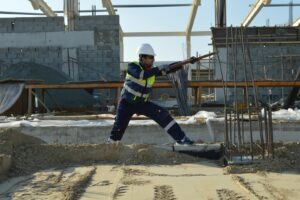 Soaring unemployment and welfare cuts led to riots in the 1980s. Has a quarter of a century of regeneration made us more resilient to such shocks? Clare Goff visits the scene of a notorious flashpoint to find out
Soaring unemployment and welfare cuts led to riots in the 1980s. Has a quarter of a century of regeneration made us more resilient to such shocks? Clare Goff visits the scene of a notorious flashpoint to find out
(First published in New Start in August 2010)
‘A lot of people have a lot of gripes and there isn’t an avenue for them to raise them.’
Vanley Burke has lived in the Handsworth area of Birmingham since 1965. His chronicling of life there, including the riots of the 1980s, have seen him dubbed the grandfather of black British photography.
In 1985, with a microphone stuck to his forehead to allow him to simultaneously snap pictures and interview participants, he witnessed how police harassment of young black men turned into bloody riots in which two people died.
‘Youths had their backs pushed against the wall. The riots were against the system, and the unfairness of the situation people found themselves in.’
Twenty-five years on from the most bloody of the 1980s riots and much has changed in northwest Birmingham. Still a reception area for immigrants, the Irish, Afro-Caribbean and Asian populations, which dominated in the 1980s, have been added to by migrants from 169 countries across the globe. On the Soho Road, Polish grocery stores and halal butchers sit alongside Asian funeral directors. The Sikh gurdwara jostles for attention on the skyline with St George’s church.
And there is another new addition to the area since the 80s. Dotted in between the shops, community organisations and religious centres are the hoardings of regeneration programmes past and present. The previous Tory administration poured millions into inner city areas in the wake of the violence of the 80s, focusing primarily on the physical environment and on jobs schemes for disenfranchised youth. Labour’s more holistic approach continued the trend, so much so that in 2005 an academic study noted ‘partnership overload’ in the area.
Today, a few frayed hoardings of SRB6 remain but the most visible sign of change comes from Urban Living, the housing market renewal pathfinder for the area. Many of its projects sit tantalisingly behind shiny hoardings displaying local characters, including Vanley Burke himself. The area has changed, but according to Mr Burke, some of the issues which caused the tensions have not. ‘I don’t think it’s better – you just need to have something to flare up again’.
As poverty and unemployment rise and public service cuts kick in, some are predicting a return to the urban violence of the 80s, when inner-city areas of Liverpool, Bristol, Birmingham, Leeds and London erupted in violence.
The limitations of regeneration
Have the millions spent on regeneration in the last 30 years made these areas less prone to riots? The question was answered in northwest Birmingham in 2005, when violence erupted again in nearby Lozells, this time fuelled by the alleged rape of a young black woman by Asians. In the media the disturbance, which lasted two days and again led to the death of two men, was portrayed as inter-racial. But to those working closer to the ground in the area, the flare-up exposed the failings of the regeneration schemes put in place to tackle the root causes of the 1980s riots.
In a report analysing the 2005 disturbances, Peter Latchford, chief executive of project management consultancy Black Radley and now non-executive director of Urban Living, concluded that despite – and to some degree because of – the processes and mechanisms introduced to address issues in the area since the 1980s, the health, housing, employment, skills, regeneration and social problems remain.
‘It is no surprise therefore that the average Lozells citizen might see little value in such mechanisms, over and above the slim employment opportunity the agencies themselves represent,’ the report concluded.
Despite its damning conclusion the report congratulates the efforts of statutory agencies to be more responsive to the needs of Birmingham’s citizens. Community engagement has changed dramatically in the last 30 years: local policing and other services understand the need to listen to all sections of the communities they serve; councils work harder to ensure services are in tune with the needs of neighbourhoods, through local strategic partnerships and other channels.
But, in its eagerness to be seen to be engaging and responding to the needs of local communities, regeneration has gone too far, its focus on processes and mechanisms taking away from the real relationships needed to bring about social change.
In his report, Mr Latchford raised concern at the ‘process orientation’ of the public sector’s relationship with local communities. ‘Relationships are not corporate assets: they concern connections between individuals. If the corporate ways of working ignore or stifle such relationships, however well intentioned the targets set and the programmes undertaken, gaps, tensions and inequities will remain.’
Northwest Birmingham has moved on considerably since the 80s. It is less impoverished and gross discrimination against ethnic groups has diminished, but, Mr Latchford says, the fundamentals have not improved as much as expected. The same is true of other areas that experienced violence and deprivation during the 80s; while regeneration has helped protect communities from further disadvantage and exclusion, high levels of inequality, poverty and disaffection remain.
Perhaps it is enough that regeneration has helped such communities keep their heads above water amid an economic system that has valued growth above wellbeing.
But the cracks in the orthodoxy are beginning to show. To Mr Latchford, progress is being hindered by the ‘scientific, masculine management model of regeneration’. Driven by data, targets and efficiencies, it ‘pushes’ services onto communities and awards contracts to the biggest and most efficient supplier rather than the one that will boost the local economy.
Most of all, despite the rise of engagement and partnership approaches, relationships between the public sector and the community have ‘almost fallen backwards, to a child-adult rather than an adult-adult relationship’, he says. In his recommendations for the area he pinpointed a ‘strengthening of relationships’ as the only real and long- term solution to Handsworth’s problems.
An asset-based approach
In the wake of the 2005 disturbances Saidul Haque and other local members of the community were coming to the same conclusion.
Mr Haque had witnessed wave after wave of regeneration in the area – ‘I should have a Scout’s badge for the all projects that have been here,’ he says – but not enough change. Shocked by the violence and fed up with local representation and lack of delivery from regeneration initiatives, he and others decided to take matters into their own hands.
They shook up the Lozells Neighbourhood Forum to make it more representative of the whole community and visited council officials and regeneration bosses to tell them exactly what they thought of them. To Mr Haque the number one issue for regeneration of communities is not building the capacity of local people but building the capacity of council and other public service officials so that they are truly ‘partners’, able to listen and react to the needs of the local community.
Urban Living was the ‘first to take a punch on the nose’, he says, and he has since witnessed a change in its mindset as a response.
For, beyond the hoardings and the physical changes, the real work of the pathfinder has been on the less tangible assets of the community. It casts itself in the role of enabler and catalyst of local change; its future plan is as an asset- backed and community-led vehicle which sits midway between the community and public sector and which takes social capital as its most significant measure.
The focus of each of its interventions is on its contribution to social cohesion, how it links into the community’s broader agenda. Four of its board members are local residents, including Mr Haque, and Mr Latchford says they deliberately chose people who are more ‘difficult’.
The pathfinder has a budget of £1.2m for cohesion projects including a community arts programme and is currently refurbishing a former bank as a community asset.
Urban Living is breaking away from the dominant ‘patrician’ orthodoxy of regeneration and there are signs that others are following suit. Some councils have introduced progressive procurement, focusing on small contracts that benefit the local and social economy rather than seeking efficiencies which mean money spins out of the area.
Such steps rebalance regeneration and strengthen local relationships; those living in areas affected by regeneration feel less out of control if they are being listened to and can see change.
A recent pilot study by the Centre for Local and Economic Strategies (Cles) identified strong local relationships as key to the resilience of areas, allowing them to be protected and bounce back from economic, environmental or social shocks, including riots.
Of its 13 measures of resilience, six are focused on the strength of relationships between the public, commercial and social sectors.
Thus, while a strong commercial sector is important, the resilience of an area also depends on how local commerce relates to the public sector and the social sector. Does the chamber of commerce meet regularly with the public sector, for example? Does local commerce support its community, by funding volunteering programmes or skills training for example? Likewise, is the relationship between the public sector and the social sector strong?
It is networks that matter when shocks occur, and, as northwest Birmingham has found, the quality of local relationships. ‘You can’t have a mechanised and linear approach,’ says Neil McInroy, chief executive of Cles. ‘You need interconnected networks. Just as an ecologist talks of complex, adaptive eco-systems, communities need to be similarly adaptive to events and changes.’
Out with big regeneration, in with Big Society
As the austerity Budget rolls out, the resilience of local communities will be tested. Big regeneration is stepping aside, primarily out of necessity as government slashes spend, but also through a growing sense that it hasn’t worked as well as it could. In its place comes Big Society, which is either an invigorating rebalancing of the state’s relationship with individuals and communities, or a vague idea that tea and cakes will fill the space of services. The weave of community networks that the government’s Big Society champion, Nat Wei, wants to tap into could not be stronger than in northwest Birmingham, where voluntary community organisers like Mr Haque and numerous third sector groups work tirelessly to improve their locality.
While Mr Haque could be the embodiment of the type of community organiser David Cameron is looking to recruit, to him Big Society is just another government term to be filed alongside ‘community cohesion’.
For ‘society’ is not something ‘out there’ that can be created and morphed to the will of government. Lessons that ‘big regeneration’ is learning are that top-down measures and systemised relationships add to the lack of control and powerlessness felt by those most in need of its benefits.
Public sector cuts will exacerbate frustrations and test relationships between the public sector and communities. Big Society can help protect communities from upcoming shocks but it will need a more understanding, enabling, supportive – and smaller – regeneration sector to help it to do so.

















Leave a Reply